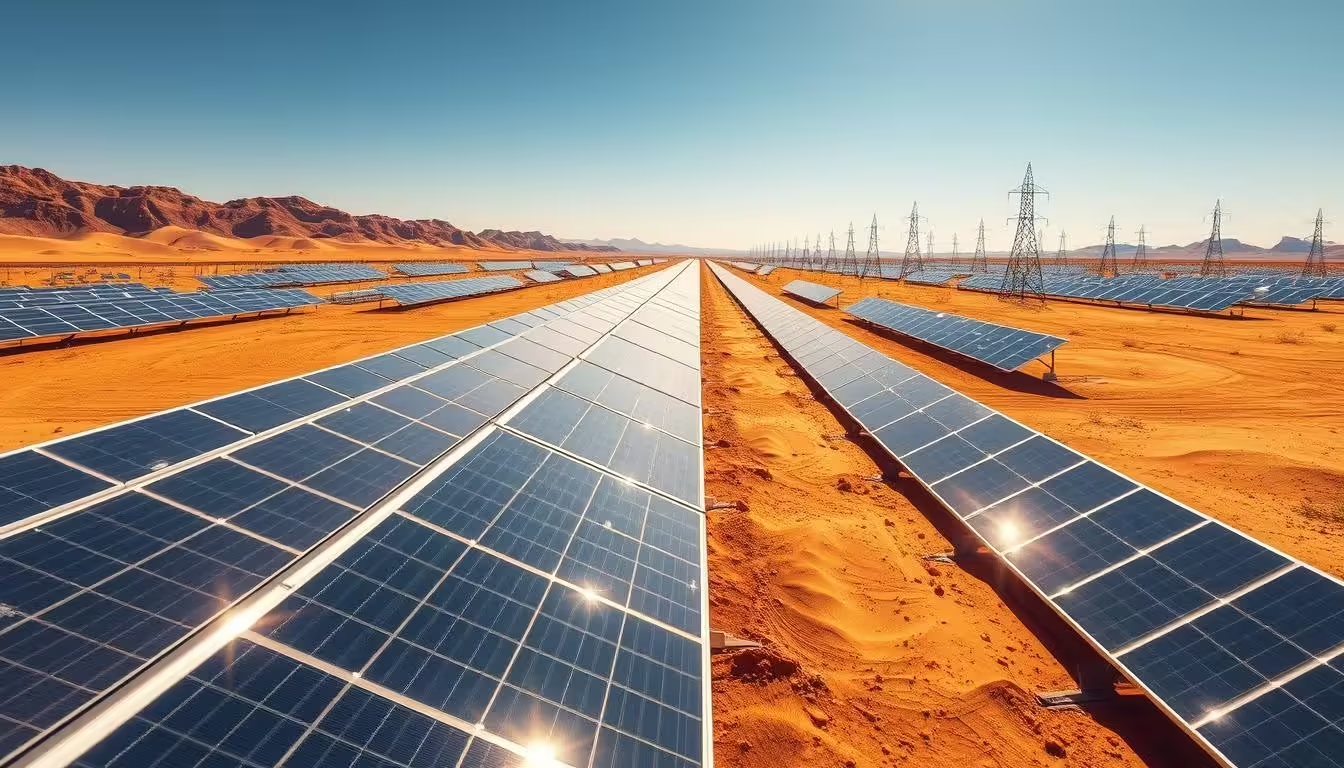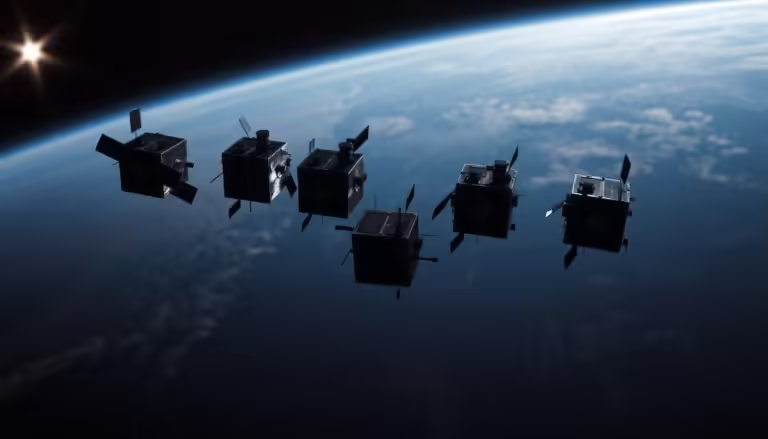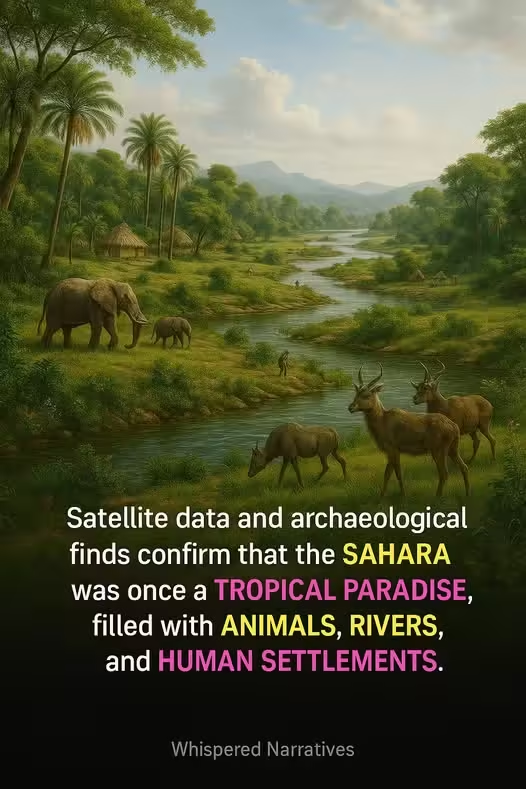The world is witnessing a significant shift towards renewable energy, and solar farms in deserts are playing a crucial role in this transition.

By harnessing the abundant sunlight in desert regions, these solar farms are generating clean energy on a massive scale, powering millions of homes and reducing our reliance on fossil fuels.
This transformation is not only beneficial for the environment, but also contributes to a more sustainable future.
Key Takeaways
- Solar farms in deserts are a significant source of clean energy.
- Desert regions provide abundant sunlight for solar energy generation.
- The use of solar farms reduces reliance on fossil fuels.
- Solar energy contributes to a more sustainable future.
- The development of solar farms is a growing trend in renewable energy.
The Rise of Desert Solar Power
The deserts of the world are undergoing a transformation, becoming hubs for clean energy. This shift is not just about generating power; it’s about reimagining the role of deserts in our global energy landscape.
From Barren Land to Energy Goldmines
Historically, deserts have been viewed as barren and unproductive lands. However, with the advent of solar technology, these regions are now being transformed into energy goldmines.
Historical Desert Land Usage
Deserts have traditionally been used for limited agricultural purposes or left untouched due to their harsh conditions. The advent of solar energy has changed this narrative, turning these areas into valuable resources for clean energy production.
The Solar Transformation Timeline
The transformation of deserts into solar hubs has been a gradual process, marked by significant milestones in solar technology and investment in renewable energy infrastructure.

The Perfect Match: Why Deserts and Solar Energy Work Together
Deserts offer the ideal conditions for solar energy production: abundant sunlight and vast expanses of land.
Abundant Sunlight and Available Space
Deserts receive some of the highest amounts of solar radiation on Earth, making them perfect for harnessing solar energy. The available space allows for the installation of large-scale solar farms.
Minimal Competing Land Uses
Unlike other regions, deserts have minimal competing land uses, such as agriculture or urban development, making them ideal for large-scale solar installations.
| Region | Solar Radiation | Land Use |
|---|---|---|
| Desert | High | Solar Farms |
| Mountainous | Variable | Conservation |
| Urban | Low | Development |
The combination of these factors makes deserts a perfect match for solar energy production, driving the growth of renewable energy and contributing to a more sustainable future.
How Desert Solar Farms Transform Sustainability and Green Tech
Desert solar farms represent a pivotal advancement in renewable energy, offering a cleaner alternative to traditional fossil fuels and transforming barren landscapes into energy-producing assets. This transformation is not just about generating clean energy; it’s also about driving innovation in sustainability and green technology.
The Technology Behind Desert Solar Installations
The technology used in desert solar installations is diverse and has evolved significantly over the years. Two primary technologies dominate the landscape: photovoltaic (PV) systems and concentrated solar power (CSP) systems.
Photovoltaic vs. Concentrated Solar Power Systems
Photovoltaic systems convert sunlight directly into electricity using solar panels. They are widely used due to their efficiency and relatively low maintenance. On the other hand, CSP systems use mirrors or lenses to focus sunlight onto a central tower, generating heat that is then used to produce steam and drive turbines to generate electricity.
- PV systems are modular and can be easily scaled up or down depending on energy needs.
- CSP systems can store thermal energy for extended periods, allowing for electricity generation even when the sun is not shining.
Desert-Specific Engineering Innovations
Desert environments pose unique challenges, including high temperatures and dust. To address these, engineers have developed innovative solutions such as:
- Cooling systems to improve PV panel efficiency.
- Dust-resistant coatings and regular cleaning mechanisms to maintain panel efficiency.

Comparing Desert Solar to Other Renewable Sources
When evaluating the effectiveness of desert solar farms, it’s essential to compare them with other renewable energy sources like wind and hydropower.
Efficiency and Output Metrics
Desert solar farms have high efficiency rates, especially when compared to traditional fossil fuel-based power plants. CSP systems, in particular, can achieve high temperatures, leading to efficient electricity generation.
“The potential for solar energy in desert regions is vast and largely untapped, offering a significant opportunity for clean energy production.”
Land Use Efficiency Compared to Wind and Hydropower
While desert solar farms require significant land areas, they can be built on otherwise unproductive land. In contrast, wind farms and hydropower plants have their own land use requirements and environmental impacts.
| Renewable Energy Source | Land Use Requirement | Efficiency |
|---|---|---|
| Desert Solar | High, but can use barren land | High efficiency, especially with CSP |
| Wind Power | High, requires large areas for turbines | Variable, dependent on wind speeds |
| Hydropower | Very high, requires large water reservoirs | High efficiency, but dependent on water resources |
By understanding the technology and comparative advantages of desert solar farms, we can better appreciate their role in transforming sustainability and green tech.
America’s Desert Solar Revolution: Major Projects Powering the Grid
The United States is witnessing a significant shift towards renewable energy, with desert solar projects leading the charge. This movement is not just about generating clean energy; it’s also about transforming vast, arid landscapes into powerhouses that fuel homes and businesses across the nation.
The Mojave Desert Solar Corridor
The Mojave Desert is at the heart of America’s solar revolution, hosting some of the world’s most significant solar farms. These projects are pivotal in the country’s transition to renewable energy.
Ivanpah Solar Electric Generating System
The Ivanpah Solar Electric Generating System is one of the largest solar thermal power plants in the world, capable of producing 392 MW of electricity. Located in the Mojave Desert, it uses mirrors to focus sunlight on a central tower, generating steam to power turbines.
Desert Sunlight Solar Farm
Another significant project in the Mojave is the Desert Sunlight Solar Farm, a 550-megawatt photovoltaic solar power plant. It spans over 3,900 acres and is equipped with more than 8 million solar panels, making it one of the largest solar farms in the United States.
Nevada’s Solar One and Beyond
Nevada is also a key player in the desert solar revolution, with several major projects contributing to the state’s renewable energy portfolio.
Copper Mountain Solar Facility
The Copper Mountain Solar Facility is a significant photovoltaic solar plant located in Boulder City, Nevada. With a capacity of 552 MW, it is one of the largest solar farms in the state, providing clean energy to Nevada residents.
Crescent Dunes Solar Energy Project
The Crescent Dunes Solar Energy Project is a 110 MW solar power tower project that includes a molten salt energy storage system. This innovative technology allows for energy storage, enabling the project to provide electricity even when the sun is not shining.
Arizona’s Expanding Solar Landscape
Arizona is another state where the desert solar revolution is gaining momentum, with several large-scale projects underway.
Solana Generating Station
The Solana Generating Station is a 280 MW parabolic trough solar power plant located near Gila Bend, Arizona. It features a molten salt energy storage system, allowing it to generate electricity for up to six hours after sunset.
Agua Caliente Solar Project
The Agua Caliente Solar Project is one of the largest photovoltaic solar power plants in the United States, with a capacity of 290 MW. Located in Yuma County, Arizona, it generates enough electricity to power over 230,000 homes.
These projects are not only contributing to the United States’ renewable energy goals but are also creating jobs and stimulating local economies. As the desert solar revolution continues to grow, it is expected to play a crucial role in America’s clean energy future.
| Project Name | Location | Capacity (MW) |
|---|---|---|
| Ivanpah Solar Electric Generating System | Mojave Desert, California | 392 |
| Desert Sunlight Solar Farm | Mojave Desert, California | 550 |
| Copper Mountain Solar Facility | Boulder City, Nevada | 552 |
| Crescent Dunes Solar Energy Project | Nevada | 110 |
| Solana Generating Station | Gila Bend, Arizona | 280 |
| Agua Caliente Solar Project | Yuma County, Arizona | 290 |

Powering Millions: How Desert Solar Reaches Urban Homes
Desert solar energy is revolutionizing the way we power our cities, with millions of homes now benefiting from this clean energy source. The vast potential of desert solar is being tapped into, transforming the way we think about energy production and distribution. As the demand for renewable energy continues to grow, desert solar farms are playing an increasingly important role.
Transmission Infrastructure: The Critical Link
The transmission infrastructure is a crucial component in the delivery of desert solar energy to urban homes. Major transmission projects have been undertaken to connect the desert regions to cities, overcoming the challenges posed by distance.
Major Transmission Projects Connecting Desert to Cities
Several significant transmission projects have been completed, enabling the efficient transfer of electricity from desert solar farms to urban areas. For instance, the Sunrise Powerlink project in California is a notable example, connecting the Imperial Valley to San Diego.
Overcoming Distance Challenges
To overcome the distance between desert solar farms and urban centers, advanced transmission technologies are being employed. These include high-voltage direct current (HVDC) lines, which minimize energy loss during transmission.
Urban Energy Distribution from Desert Sources
The energy generated by desert solar farms is distributed to urban homes through a network of substations and distribution lines. This energy is then used to power homes, businesses, and industries, reducing reliance on fossil fuels and lowering carbon emissions.
Real-World Impact: Communities Powered by Desert Solar
Desert solar energy is having a tangible impact on urban communities, providing clean and reliable energy. Cities such as Las Vegas and Los Angeles are benefiting from desert solar projects, with more cities set to follow.
Case Studies of Cities Running on Desert Solar
Cities like Las Vegas are already seeing the benefits of desert solar energy, with significant reductions in greenhouse gas emissions. As more desert solar projects come online, the impact is expected to grow, powering more urban homes and contributing to a cleaner environment.
“The growth of desert solar energy is a game-changer for our planet, providing a clean, sustainable source of power for millions of homes.”
Environmental Impact: Balancing Clean Energy with Desert Ecosystems
As the world shifts towards renewable energy, desert solar farms are emerging as a key player, with significant environmental implications. While these installations are crucial for generating clean energy, their presence in desert ecosystems raises important questions about sustainability and environmental stewardship.
Water Usage Concerns and Solutions
One of the primary environmental concerns associated with desert solar farms is water usage. Traditional solar panel cleaning and cooling systems can consume significant amounts of water, a precious resource in arid desert environments.
Dry Cooling Technologies
Dry cooling technologies offer a promising solution to reduce water consumption. By using air instead of water to cool the systems, dry cooling minimizes the impact on local water resources.
Water Recycling Systems
Implementing water recycling systems is another effective strategy. These systems allow for the reuse of water for cleaning and other purposes, further reducing the demand on local water supplies.
Wildlife Protection Measures
Desert solar farms also pose risks to local wildlife, including protected species such as the desert tortoise. To mitigate these impacts, developers are implementing various wildlife protection measures.
Desert Tortoise Conservation Efforts
Conservation efforts specifically targeting the desert tortoise include habitat restoration and relocation programs. These initiatives help minimize the impact of solar farm development on tortoise populations.
Bird-Safe Design Innovations
Bird-safe design innovations are being integrated into solar farm layouts to reduce bird collisions and fatalities. These designs take into account the flight patterns of local bird species, ensuring that the installations are as safe as possible for avian wildlife.
Land Use Efficiency and Conservation Efforts
Land use efficiency is another critical aspect of minimizing the environmental footprint of desert solar farms. By optimizing the layout and design of solar installations, developers can reduce the overall land area required.

Effective conservation efforts, including habitat restoration and wildlife corridors, are also being implemented to protect local ecosystems. These measures help maintain biodiversity and ensure that the environmental benefits of clean energy production are not outweighed by negative impacts on desert ecosystems.
Economic Benefits: Jobs, Investment, and Energy Independence
Desert solar farms are transforming the economic landscape of rural areas across the United States. By harnessing the abundant sunlight in these regions, solar farms are not only generating clean energy but also creating new economic opportunities for local communities.
Employment Opportunities in Desert Communities
The development of solar farms in desert areas is creating a range of employment opportunities. During the construction phase, local workers are employed for installation jobs, boosting the local economy.
Construction and Installation Jobs
These jobs not only provide immediate employment but also help in developing a skilled workforce in the renewable energy sector.
Long-term Maintenance and Operations Positions
Once operational, solar farms require ongoing maintenance, creating long-term jobs that contribute to the sustainability of local economies.
Economic Revitalization of Rural Areas
The economic benefits of desert solar farms extend beyond job creation. These projects also contribute to the revitalization of rural areas through tax revenue generation and support for local businesses.
Tax Revenue Generation
Solar farms generate significant tax revenue for local governments, which can be used to fund public services and infrastructure.
Supporting Local Businesses
Moreover, the presence of solar farms often leads to the development of supporting local businesses, further stimulating economic growth.
Reducing Energy Import Dependence
By generating energy locally, desert solar farms help reduce our dependence on imported energy, enhancing energy security and promoting energy independence.

The growth of renewable energy through desert solar farms is a significant step towards achieving energy independence, contributing to a more sustainable and economically resilient future.
Overcoming Challenges: From Technical Hurdles to Policy Support
Desert solar projects face numerous challenges, from technical issues to policy support, that must be addressed for success. Despite these obstacles, the industry is making significant strides in overcoming them.
Dust, Heat, and Maintenance Solutions
The harsh desert environment poses significant technical challenges, including dust accumulation on solar panels and extreme heat that can reduce efficiency. To combat these issues, innovative solutions are being implemented.
Automated Cleaning Systems
Automated cleaning systems are being used to remove dust and debris from solar panels, ensuring maximum energy production. These systems can be programmed to clean panels at optimal times, reducing water usage and maintenance costs.
Heat-Resistant Materials and Designs
Advances in heat-resistant materials and panel designs are helping to mitigate the effects of extreme temperatures on solar panels. These innovations enable panels to operate more efficiently in high-temperature conditions.

Energy Storage Innovations
Energy storage is a critical component of desert solar projects, enabling the storage of excess energy generated during the day for use during periods of low sunlight or at night.
Battery Integration Projects
Battery integration projects are becoming increasingly common, allowing for the efficient storage of solar energy. Advances in battery technology are improving the viability of desert solar projects.
Thermal Storage Solutions
Thermal storage solutions involve storing energy in the form of heat, which can then be used to generate electricity when needed. This technology is particularly well-suited to desert solar applications.
| Technology | Description | Benefits |
|---|---|---|
| Automated Cleaning Systems | Programmed cleaning of solar panels | Reduced maintenance costs, increased efficiency |
| Heat-Resistant Materials | Advanced materials for panel construction | Improved panel longevity, increased efficiency in high temperatures |
| Battery Integration | Storage of excess solar energy | Stable energy supply, reduced grid dependence |
Policy Frameworks Supporting Desert Solar Development
Policy support is crucial for the continued growth of desert solar projects. Various frameworks are in place to encourage development.
Federal Incentives and Programs
Federal incentives, such as tax credits, play a significant role in supporting desert solar development. These incentives help to offset the high upfront costs associated with solar projects.
State-Level Renewable Portfolio Standards
State-level renewable portfolio standards (RPS) require utilities to generate a certain percentage of their electricity from renewable sources, driving demand for desert solar energy.
By addressing technical challenges and leveraging policy support, the desert solar industry is poised for continued growth and success.
The Future of Desert Solar: Emerging Technologies and Expansion Plans
The desert solar industry is on the cusp of a revolution, driven by emerging technologies and expansion plans. As the world continues to transition towards renewable energy sources, desert solar is poised to play an increasingly vital role in the global energy landscape.
Next-Generation Solar Technologies for Harsh Environments
Desert solar farms are benefiting from next-generation technologies designed to improve efficiency and resilience in harsh environments. Two significant advancements are bifacial solar panels and perovskite solar cell developments.
Bifacial Solar Panels
Bifacial solar panels can generate electricity from both the front and back sides of the panel, increasing energy output by up to 25%. This technology is particularly beneficial in desert environments where sunlight is abundant.
Perovskite Solar Cell Developments
Perovskite solar cells offer the potential for higher efficiency rates and lower production costs compared to traditional silicon-based cells. Researchers are working to overcome stability issues to make this technology commercially viable.
Hybrid Systems: Combining Solar with Other Renewables
Hybrid systems that combine solar power with other renewable energy sources are becoming increasingly popular. Two promising approaches are solar-wind hybrid projects and integrating green hydrogen production.
Solar-Wind Hybrid Projects
Solar-wind hybrid projects leverage the complementary nature of solar and wind energy to provide a more consistent power output. These projects can optimize land use and reduce the variability associated with individual renewable sources.
Integrating Green Hydrogen Production
Integrating green hydrogen production with desert solar farms offers a promising pathway for storing and utilizing excess energy. Green hydrogen can be used as a clean fuel for transportation and industrial applications.
Projected Growth and Capacity Additions Through 2030
The future of desert solar looks bright, with significant growth projected through 2030. According to industry forecasts, desert solar capacity is expected to increase substantially, driven by technological advancements and supportive policies.
| Year | Projected Capacity (GW) | Growth Rate (%) |
|---|---|---|
| 2025 | 15 | 20 |
| 2028 | 30 | 25 |
| 2030 | 50 | 30 |
As shown in the table, the projected growth rate for desert solar capacity is expected to accelerate through 2030, driven by emerging technologies and expanding project pipelines.
Conclusion: Desert Solar’s Role in Our Clean Energy Future
Desert solar is playing a vital role in our transition to a clean energy future. By harnessing the abundant sunlight in desert regions, we can generate clean energy on a massive scale, reducing our reliance on fossil fuels and mitigating climate change.
The development of desert solar farms has transformed barren landscapes into clean energy hubs, powering millions of homes across the United States. As we continue to innovate and invest in desert solar technology, it is essential to balance clean energy production with environmental concerns, such as water usage and wildlife protection.
The future of desert solar looks promising, with emerging technologies and expansion plans on the horizon. By combining desert solar with other renewable energy sources and energy storage innovations, we can create a more sustainable and resilient energy grid.
As we move forward, it is crucial to continue supporting desert solar development through policy frameworks and investment in infrastructure. By doing so, we can ensure that desert solar remains a key component of our renewable energy mix, driving us towards a cleaner, more sustainable energy future.




